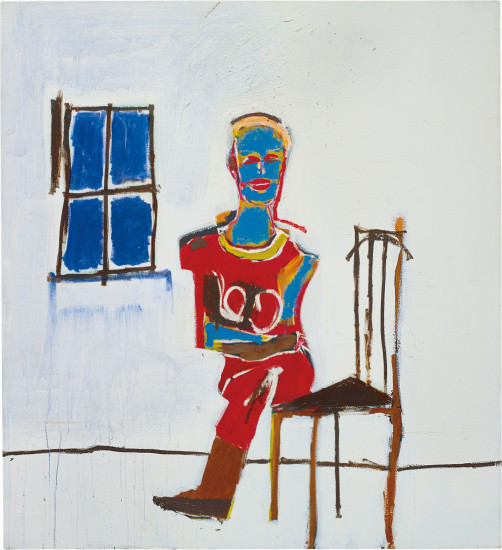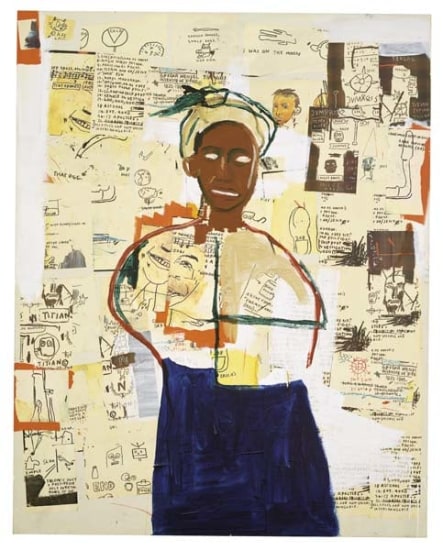Jean-Michel-Basquiat Untitled (Lung) 1986 Acrylic on wood. 96 1/2 x 55 in. (245.1 x 139.7 cm.) Signed and dated “Basquiat 86” on the reverse.
Provenance Galerie Bruno Bischofberger, Zurich Exhibited Paris, Galerie Daniel Templon, Jean-Michel-Basquiat, Oeuvres récentes, January 10 – February 7, 1987; Beverly Hills, Gagosian Gallery, Jean-Michel-Basquiat, Paintings and Drawings 1980-1988, February 12 – March 14, 1998, no 47 (illustrated in color); Künzelsau, Museum Würth, Jean Michel Basquiat, Gemälde und Arbeiten auf Papier (Paintings and works on paper), September 27, 2001 – January 1, 2002 Literature Galerie Enrico Navarra, Jean-Michel-Basquiat, Paris, 1996, p. 145, no. 3 (illustrated in color) and p. 217 (installation view); Jean-Michel-Basquiat: paintings and drawings, 1980-1988, Los Angeles, 1998, no. 47 (illustrated in color); J. Baal-Teshuva, Jean Michel Basquiat, Gemälde und Arbeiten auf Papier (Paintings and works on paper), Künzelsau, 2001, p. 99 (illustrated in color) Catalogue Essay Basquiat’s repeated use of anatomical imagery — skeletons, musculature, and internal organs — coincides with an ever more widespread tendency in his work to turn things inside out. Inner thoughts are made public in graffiti-like litanies of words and other bursts of expression; distinctions between private spaces and public places are dissolved; past and present are interwoven, and levels of reality are multiplied and scrambled; the imagined realms of paradise, hell and purgatory become indistinguishable. (Jeffrey Hoffeld, “Basquiat and the inner self,” Jean-Michel-Basquiat Paintings and Works on Paper, 2001, p. 27) Jean-Michel-Basquiat defined American Art in the 1980s. Basquiat’s artistic career began in the late 1970s, when he was producing artwork as a graffiti artist under the pseudonym “SAMO.” The street and the urban landscape was Basquiat’s canvas. All of New York City’s public spaces were available to him and his work became instantly visible to and activated by passers-by. People of diverse backgrounds took notice: “Samo’s early public markings and images on canvas, paper and wood…conveyed a striking sense of isolation (and…loneliness) shamelessly displayed so as to append something almost sinister to a vulnerability that became in itself a shield.” In a relatively short period of time, SAMO’s graffiti gained cult notoriety. His work was featured in the Village Voice’s historic December 1978 article on the rise and importance of graffiti artists in New York City, to which Basquiat ironically replied a year later “SAMO IS DEAD,” officially ending that chapter of his career. The early 1980s were a pivotal time for Basquiat’s artistic development. In 1981, he was featured in Glenn O’Brien’s seminal documentary Downtown ’81 and was subsequently introduced to Andy Warhol an artist who would become a mentor and confidant. Basquiat’s artistic career is often described as a meteoritic rise, punctuated by key moments that include Art Forum’s seminal Radiant Child article, his debut exhibition with legendary art dealer Annina Nosei, and sold-out exhibitions with Mary Boone, a gallery that defined and emblematized the spirit of the 80s. A year before Basquiat’s death in 1988, he was featured on the cover of The New York Times in an article titled “New Art, New Money: The Marketing of an American Artist.” It was a harbinger for the fall of the 1980s stock market and the first major art world recession. Language has always played a central role in Basquiat’s work. Throughout his oeuvre, the vernacular of street culture slowly became integrated into commercial and institutional systems. The embedded politics in Basquiat’s paintings, such as Irony of Negro Policeman (1981), were now visible to larger communities, and consequently the voice and position of a marginalized body politic, otherwise unrepresented, took center stage. Primarily using found materials; the realities of urban culture were made manifest in Basquiat’s choice of medium. “At the beginning of 1981, he had been painting on found objects, discarded windows, doors, pieces of wood and metal; the debris of New York Ci
Jean-Michel-Basquiat Untitled (Lung) 1986 Acrylic on wood. 96 1/2 x 55 in. (245.1 x 139.7 cm.) Signed and dated “Basquiat 86” on the reverse.
Provenance Galerie Bruno Bischofberger, Zurich Exhibited Paris, Galerie Daniel Templon, Jean-Michel-Basquiat, Oeuvres récentes, January 10 – February 7, 1987; Beverly Hills, Gagosian Gallery, Jean-Michel-Basquiat, Paintings and Drawings 1980-1988, February 12 – March 14, 1998, no 47 (illustrated in color); Künzelsau, Museum Würth, Jean Michel Basquiat, Gemälde und Arbeiten auf Papier (Paintings and works on paper), September 27, 2001 – January 1, 2002 Literature Galerie Enrico Navarra, Jean-Michel-Basquiat, Paris, 1996, p. 145, no. 3 (illustrated in color) and p. 217 (installation view); Jean-Michel-Basquiat: paintings and drawings, 1980-1988, Los Angeles, 1998, no. 47 (illustrated in color); J. Baal-Teshuva, Jean Michel Basquiat, Gemälde und Arbeiten auf Papier (Paintings and works on paper), Künzelsau, 2001, p. 99 (illustrated in color) Catalogue Essay Basquiat’s repeated use of anatomical imagery — skeletons, musculature, and internal organs — coincides with an ever more widespread tendency in his work to turn things inside out. Inner thoughts are made public in graffiti-like litanies of words and other bursts of expression; distinctions between private spaces and public places are dissolved; past and present are interwoven, and levels of reality are multiplied and scrambled; the imagined realms of paradise, hell and purgatory become indistinguishable. (Jeffrey Hoffeld, “Basquiat and the inner self,” Jean-Michel-Basquiat Paintings and Works on Paper, 2001, p. 27) Jean-Michel-Basquiat defined American Art in the 1980s. Basquiat’s artistic career began in the late 1970s, when he was producing artwork as a graffiti artist under the pseudonym “SAMO.” The street and the urban landscape was Basquiat’s canvas. All of New York City’s public spaces were available to him and his work became instantly visible to and activated by passers-by. People of diverse backgrounds took notice: “Samo’s early public markings and images on canvas, paper and wood…conveyed a striking sense of isolation (and…loneliness) shamelessly displayed so as to append something almost sinister to a vulnerability that became in itself a shield.” In a relatively short period of time, SAMO’s graffiti gained cult notoriety. His work was featured in the Village Voice’s historic December 1978 article on the rise and importance of graffiti artists in New York City, to which Basquiat ironically replied a year later “SAMO IS DEAD,” officially ending that chapter of his career. The early 1980s were a pivotal time for Basquiat’s artistic development. In 1981, he was featured in Glenn O’Brien’s seminal documentary Downtown ’81 and was subsequently introduced to Andy Warhol an artist who would become a mentor and confidant. Basquiat’s artistic career is often described as a meteoritic rise, punctuated by key moments that include Art Forum’s seminal Radiant Child article, his debut exhibition with legendary art dealer Annina Nosei, and sold-out exhibitions with Mary Boone, a gallery that defined and emblematized the spirit of the 80s. A year before Basquiat’s death in 1988, he was featured on the cover of The New York Times in an article titled “New Art, New Money: The Marketing of an American Artist.” It was a harbinger for the fall of the 1980s stock market and the first major art world recession. Language has always played a central role in Basquiat’s work. Throughout his oeuvre, the vernacular of street culture slowly became integrated into commercial and institutional systems. The embedded politics in Basquiat’s paintings, such as Irony of Negro Policeman (1981), were now visible to larger communities, and consequently the voice and position of a marginalized body politic, otherwise unrepresented, took center stage. Primarily using found materials; the realities of urban culture were made manifest in Basquiat’s choice of medium. “At the beginning of 1981, he had been painting on found objects, discarded windows, doors, pieces of wood and metal; the debris of New York Ci

.jpg)










Try LotSearch and its premium features for 7 days - without any costs!
Be notified automatically about new items in upcoming auctions.
Create an alert